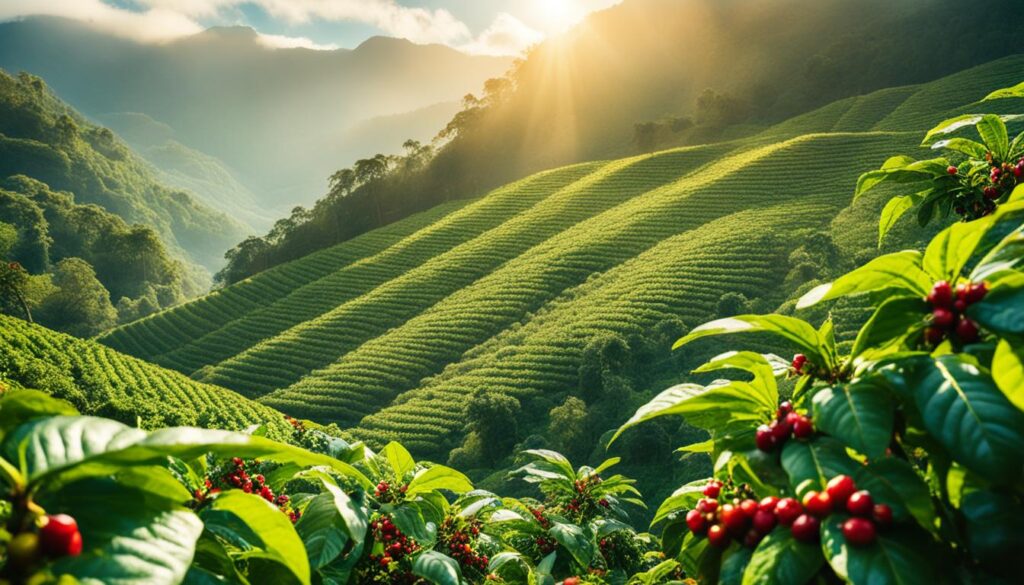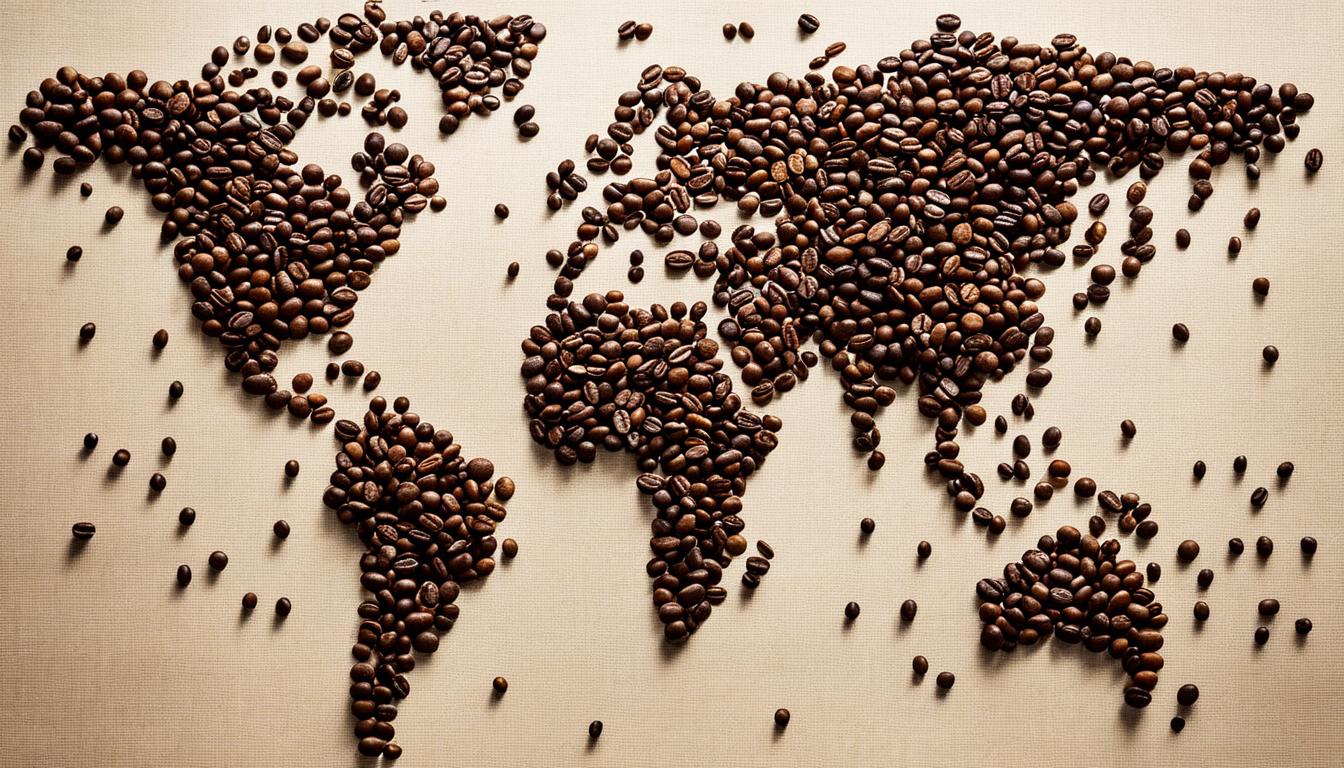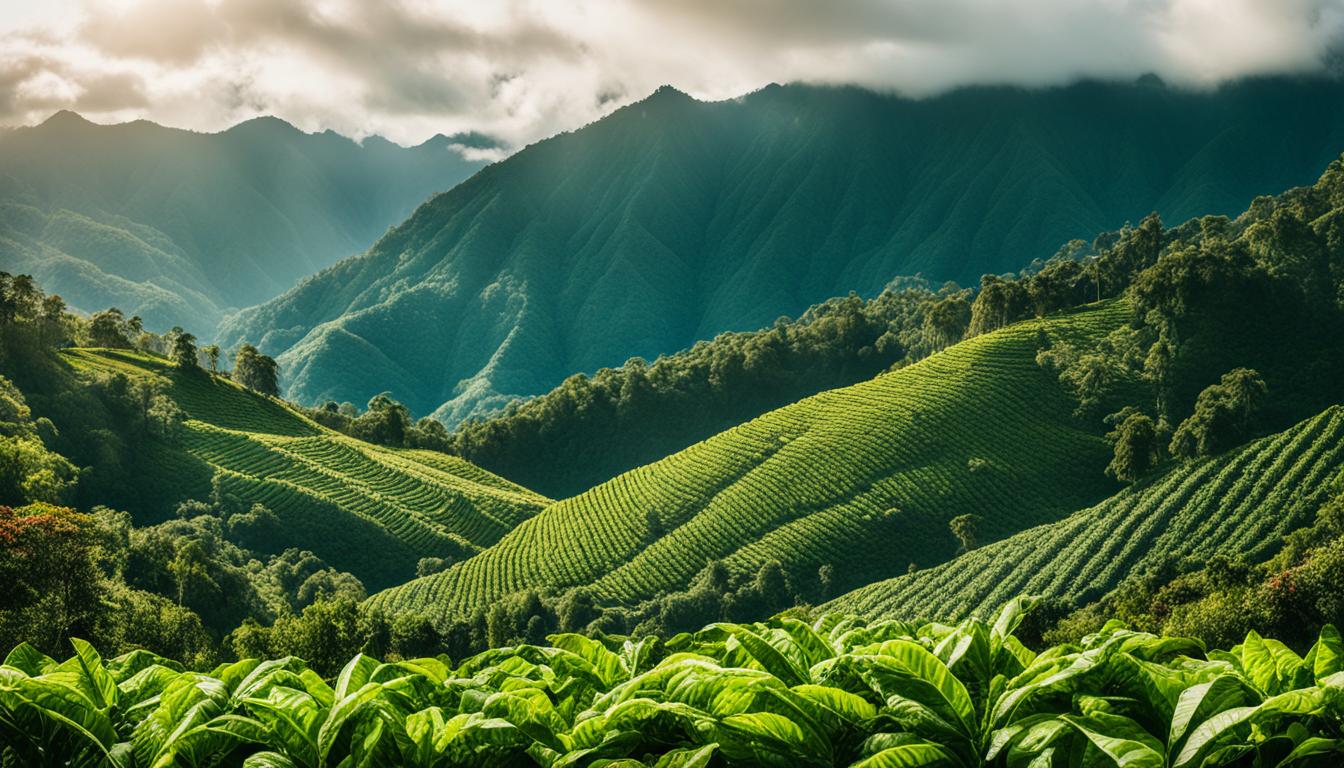Coffee is more than just a morning pick-me-up; it’s a global beverage with a diverse range of flavors. Have you ever wondered why coffee tastes different depending on where it’s grown? It’s all about geography! Let us take you on a journey through the geographical guide to coffee beans, uncovering the origins and unique characteristics of this beloved beverage.
When it comes to coffee origins, there are three primary regions that dominate the coffee bean geography. Central and South America, Africa and the Middle East, and Southeast Asia form what is known as the “Bean Belt,” located along the equatorial zone between the Tropic of Cancer and the Tropic of Capricorn.
The differences in soil chemistry, weather patterns, altitude, and processing methods contribute to the distinct regional flavors of coffee beans. From the rich and full-bodied coffees of Ethiopia to the mild and delicate flavors of Vietnam, each region brings its own unique taste to the table.
Key Takeaways:
- Central and South America are known for well-balanced, medium-bodied coffee with clean and bright flavors.
- Africa and the Middle East offer a unique and complex flavor profile with rich and full-bodied coffees.
- Southeast Asia showcases distinct flavors, from the rich and earthy beans of Indonesia to the mild and delicate flavors of Vietnam.
- The geography of coffee plays a significant role in determining its flavor profile.
- Exploring the geographical guide to coffee beans allows you to discover the world’s best coffee growing regions and the unique tastes they have to offer.
Central and South America Coffee Regions
In Central America, we find an array of coffee-producing countries that contribute to the rich tapestry of flavors in the coffee world. Guatemala, Nicaragua, El Salvador, Honduras, and Costa Rica are among the prominent coffee producers of this region.
Central America is well-known for producing well-balanced, medium-bodied coffees. These coffees boast a medium acidity that perfectly complements their clean and bright taste. They provide a delightful sensory experience, capturing the essence of the tropical climate they are cultivated in.
Among the countries in Central America, Costa Rica stands out for its exceptional coffee quality. The aromatic flavors found in Costa Rican coffee make it a favorite among coffee enthusiasts.
South America, a continent renowned for its coffee production, is home to some of the world’s largest coffee producers. Brazil, Colombia, Bolivia, and Ecuador dominate the South American coffee market. Brazilian coffee, in particular, holds the distinction of being the largest coffee producer globally.
Brazilian coffee beans are characterized by their high volume of production and versatile flavors. They contribute to the global coffee industry with their unique taste profiles and strong presence in the market. On the other hand, Colombian coffee holds great prestige and popularity worldwide, owing to its mild-bodied nature, clean cup, and distinct chocolate undertones.
| Central America | South America |
|---|---|
| Guatemala | Brazil |
| Nicaragua | Colombia |
| El Salvador | Bolivia |
| Honduras | Ecuador |
| Costa Rica |
Central and South America play a significant role in the world of coffee, offering a diverse selection of beans and flavors. This region is a treasure trove for coffee enthusiasts, allowing them to explore the wide variety of Central American and South American coffee bean varieties.
Africa and the Middle East Coffee Production
In the world of coffee, Africa is known as the birthplace of this beloved beverage. The countries of Ethiopia, Kenya, and Tanzania stand out as major coffee producers, each offering their own unique flavors and profiles. Ethiopian coffee, grown in regions like Sidamo, Harer, and Kaffa, is renowned for its diverse range of flavors that cater to various taste preferences.
When it comes to Ethiopian coffee, one can explore the different Arabica bean varieties, such as Longberry, Shortberry, and Mocha, each with their own distinct flavor profiles. These Ethiopian Arabica beans are globally recognized for producing exceptional coffee with intricate notes and delightful aromas.
“Ethiopian coffee is a treasure trove of flavors, from the floral and fruity to the spicy and wine-like. It is a sensory experience that takes you on a journey through the rich history and cultural significance of coffee in Ethiopia.”
– Coffee connoisseur, Aisha Abdullahi
Moving to the Middle East, Yemen also holds a significant place in coffee production. Yemeni coffee shares similarities with Ethiopian coffee, both in terms of flavor and attributes. Yemeni coffee is renowned for its bright acidity, full-bodied characteristics, and spicy undertones, making it a captivating brew for coffee enthusiasts.
Discovering the Flavors of African Coffee
Exploring African coffee is like embarking on a taste adventure across diverse landscapes and cultures. From the birthplace of coffee in Ethiopia to the unique profiles of Kenyan and Tanzanian beans, African coffee offers a sensory experience like no other.
As an Ethiopian coffee lover, I am constantly amazed by the vibrant flavors and aromas that each cup brings. The richness and diversity of Ethiopian Arabica beans always leave me wanting more. Whether it’s a fruity and floral Yirgacheffe or a bold and chocolatey Sidamo, Ethiopian coffee never fails to delight my taste buds.
- Discover the diverse flavors of African coffee
- Experience the unique profiles of Ethiopian Arabica beans
- Indulge in the bright and full-bodied brew of Yemeni coffee
Join us on this journey as we continue to explore the fascinating world of coffee and its geographical influences on flavor. In the next section, we’ll take a closer look at the coffee regions of Southeast Asia and the distinctive flavors they offer.
Southeast Asia Coffee Regions
Southeast Asia is renowned for its vibrant coffee culture and diverse range of coffee-producing countries. In this section, we will take a closer look at the unique flavors and characteristics of Indonesian Coffee, Vietnamese Coffee, Sumatra Coffee, and Laos Coffee.
Indonesian Coffee
Indonesia, a sprawling archipelago, is home to some of the world’s finest coffee beans. Grown on islands like Sulawesi, Java, and Sumatra, Indonesian coffee is known for its distinct, full-bodied flavor with clean and smooth characteristics. The volcanic soil of the region, coupled with the tropical climate, creates the perfect conditions for cultivating high-quality Arabica and Robusta beans. Indonesian coffee is a favorite among coffee enthusiasts for its rich and earthy taste, often accompanied by notes of dark chocolate and spices.
Vietnamese Coffee
Vietnam has made itself a significant player in the coffee industry, being the second-largest coffee exporter worldwide. Vietnamese coffee is celebrated for its mild and delicate flavors, making it a popular choice among those seeking a smooth and easy-to-drink brew. The traditional Vietnamese coffee preparation method involves using a stainless steel filter called a phin, which produces a rich and concentrated cup of coffee. Whether consumed hot or served over ice with sweetened condensed milk, Vietnamese coffee offers a delightful sensory experience.
Sumatra Coffee
Sumatra, one of the Indonesian islands, is renowned for its exceptional coffee. Coffee from Sumatra exhibits a unique low acidity, giving it a distinct flavor profile. The coffee beans grown in this region have an earthy and herbal taste, complemented by rich dark chocolate notes. Sumatra coffee is a go-to choice for coffee lovers who appreciate a robust and deeply satisfying cup of coffee.
Laos Coffee
Laos, a hidden gem in Southeast Asia’s coffee scene, is recognized for its specialty Arabica coffee. The coffee-growing regions of Laos produce beans with light citrusy and floral notes, resulting in a refined and aromatic cup. Alongside Arabica, Laos also cultivates Robusta coffee at higher altitudes, offering a bolder and more robust flavor profile. The coffee culture in Laos is vibrant, and its coffee beans are gaining recognition for their exceptional quality.

Discover the rich and distinct flavors of Indonesian Coffee, Vietnamese Coffee, Sumatra Coffee, and Laos Coffee. Each region in Southeast Asia contributes its unique taste and character to the world of coffee, making it an exciting journey for coffee enthusiasts to explore.
Conclusion
Coffee beans are not just ordinary beans; they carry the flavors of the regions where they are grown. From the lush landscapes of Central and South America to the ancient coffee plantations of Africa and the Middle East, and the vibrant coffee cultures of Southeast Asia, each coffee-growing region offers a unique taste experience.
In Central and South America, you can savor well-balanced, medium-bodied coffees with a clean and bright taste. The coffee bean harvest regions in Africa and the Middle East produce rich, full-bodied coffees with complex flavor profiles. Southeast Asia is where you can find a range of distinct flavors, from the rich and earthy beans of the Indonesian islands to the mild and delicate flavors of Vietnamese coffee.
Exploring the coffee bean location guide allows us to discover the best coffee growing regions around the world. Whether you prefer a medium-bodied brew, a full-bodied and complex cup, or a unique and distinct flavor, there is a coffee-growing region for every coffee lover. So grab your favorite mug and embark on a journey to taste the world’s best coffees right from your home.
FAQ
What is a geographical guide to coffee beans?
A geographical guide to coffee beans is a resource that provides information about the different regions around the world where coffee is grown. It highlights the unique characteristics and flavors associated with each region, allowing coffee enthusiasts to explore and discover their favorite coffee beans.
Where are the primary coffee growing regions located?
The primary coffee growing regions are located in Central and South America, Africa and the Middle East, and Southeast Asia. These regions, known as the “Bean Belt,” are situated along the equatorial zone between the Tropic of Cancer and the Tropic of Capricorn.
What are some well-known coffee producing countries in Central and South America?
Some well-known coffee producing countries in Central and South America include Guatemala, Nicaragua, El Salvador, Honduras, and Costa Rica. These countries are known for producing well-balanced, medium-bodied coffee with medium acidity and a clean, bright taste.
Which country in South America is the largest coffee producer in the world?
Brazil is the largest coffee producer in the world. It is followed by Colombia, Bolivia, and Ecuador. Brazilian coffee is known for its high volume of production, while Colombian coffee is renowned and enjoyed globally.
What are some major coffee producing countries in Africa and the Middle East?
Ethiopia, Kenya, Tanzania, and Yemen are major coffee producing countries in Africa and the Middle East. Ethiopia is particularly known as the birthplace of coffee and offers a wide range of flavors. Yemeni coffee shares similar attributes to Ethiopian coffee, while Kenya and Tanzania also produce rich and full-bodied coffees.
What are some Arabica bean varieties grown in Ethiopia?
Ethiopian Arabica bean varieties include Longberry, Shortberry, and Mocha. Each variety has its own distinct flavor profile, offering coffee enthusiasts a diverse and unique tasting experience.
Which countries in Southeast Asia are known for coffee production?
Indonesia and Vietnam are known for coffee production in Southeast Asia. Indonesian coffee is grown on islands like Sulawesi, Java, and Sumatra, and produces distinct, full-bodied beans with clean and smooth characteristics. Vietnamese coffee, on the other hand, is mild and delicate in flavor.
What are some characteristics of Sumatra coffee from Indonesia?
Sumatra coffee, a region in Indonesia, is renowned for its low acidity, earthy flavor, and rich dark chocolate notes. It offers a unique and bold coffee experience for those who enjoy a full-bodied and complex cup.
Does Laos produce specialty Arabica coffee?
Yes, Laos produces specialty Arabica coffee with light citrusy and floral notes. It is gaining recognition for its high-quality beans. Laos also grows Robusta coffee at higher altitudes, adding to the diversity of coffee offerings in the region.
What can I learn from exploring the geographical guide to coffee beans?
Exploring the geographical guide to coffee beans allows coffee connoisseurs to discover the best coffee growing regions around the world and the unique tastes they have to offer. It provides insights into the regional flavors and characteristics of coffee beans, helping you find your favorite cup of coffee.




